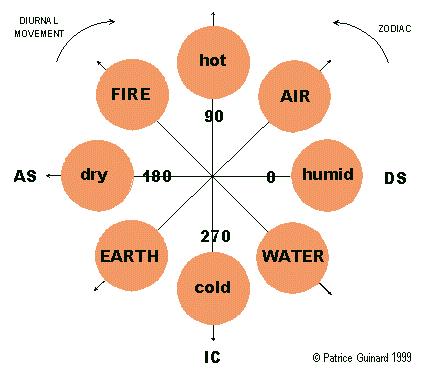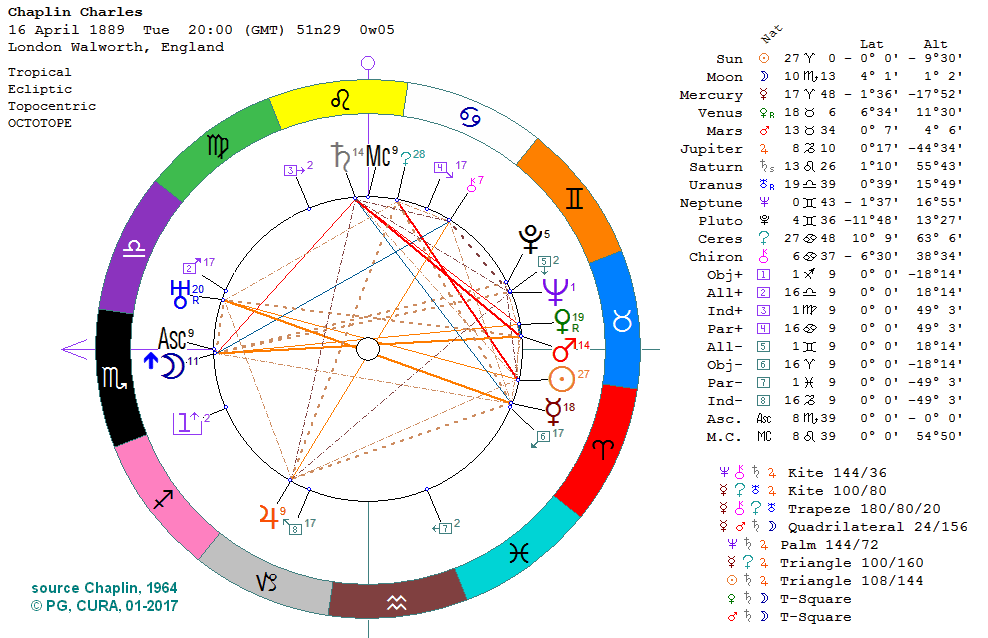For a New Approach of the Astrological Chart
by Patrice Guinard, Ph.D.
translated by E. P.
Charts and commentaries have been posted on Cura at birthdays since April 9th 2010 (see the French version of this text). They follow my study, A Reform of the astrological chart and their function is to give an insight into my method and my priorities. Due to their novelty I haven't been able to find a freeware or software that would allow me to correctly draw up the charts according to my wishes.
The Decline of contemporary astrology
Nevertheless I use the Russian software ZET (freeware version) for its relative plasticity, although it is too dependent on practices that become dominant because amateurs precisely tend to apply what they find in their software without questioning their model and practice. This is why, after the vogue of mid-points and other fantasies of the German school, waves of disciples of so-called traditional, neo-Hellenistic, neo-Arabic, neo-medieval astrology are currently propagating through the Anglo-Saxon world especially, as translations of ancient writings invade the publishing market. This is all the more pathetic that these same retarded students, who ignored almost all of the history of astrology ten years ago and whose majority never undertook any historical research work, are unaware of the most original advances amongst their predecessors of the early 20th Century, who had proposed new arrangements precisely because they were aware of the limits of this consensual, so-called traditional astrology. In other words and to simplify : today's astrologers, these "retarded Petosiris" according to the expression of Bouché-Leclercq, in the name of their recent discovery and of a consensual application of the compilations of Valens, Ptolemy, or Albumasar, Lilly, Morin et al., tend to condemn those who work at remodelling these outdated systems, precisely because they know their limits and deficiencies. This state and this evolution of astrology since about fifteen years now are considered by Robert Hand in a paper published on Astrodienst as rather encouraging... I believe on the contrary that it becomes more and more difficult to publish in specialised magazines -- which were still of a good level in the first two thirds of the 20th Century --, other papers than a mush of random interpretations and assumptions, which comfort the wide public astrologising in its mistakes.
The Illusion of interpretation
Therefore, in the following illustrations, I will limit mine to their smaller portion, merely signalling a few directions. In fact, I adhere to the thesis of some critics about the hermeneutical exercise in astrology, who underline it's random, even illusory character. For example John North in 1986 (p. xi) : "Historians faced with a nativity are almost always inclined to ask how it would have been interpreted. The answer is usually 'As its subject would have wished'." The problem is that the historians, and at a higher degree of incompetence, the scientist ideologists and popularizers, when they venture to reconstruct an ancient chart with adjusted modern data, merely reproduce the consensual models of astrologers without critical reflection. In other words, they remain at level zero in the epistemic reflection.
My Manifesto for astrology has been read in four languages by thousands of Internet users since it was put online in 1999, and has been cited by a few dozens, more as a justification of common practices than for questioning them and for the need to elaborate a renovated model compatible with the advancement of science or at least of the rationalizing mentality and aspirations of modern consciousness. This text, which was only the conclusion of a precise research work undertaken thirty years ago now, has largely eclipsed the matter it followed. When one reads there that a planet is an impressional before being a symbol, one must understand that it is ridiculous to stuff the interpretation with mythological episodes simply relative to the name more or less randomly given to new planets (Uranus, Ceres, Neptune, Pluto, even the most recent Eris, Orcus, MakeMake et al.) by astronomers sometimes hostile to astrology, -- but even if they weren't, the absurdity would remain. If Neptune had been called Mithra, Faust or Salomé, would we keep it's dignity in Pisces? New absurdity! The whole question of rulers needs to be reviewed, the more so that the Greek and medieval Petosiris did not reason differently from their modern successors and counterparts, such that it is the whole of these 'primary meanings', which are merely narrow-reaching analogies and upon which the entire interpretation exercises rests, which needs to be reevaluated. Uranus is no longer the planet of break-ups under the pretext that it was discovered a few years before the revolutionary agitation and the institutionalized terror in France at that time ; nor is Saturn, whose revolution lasts only about thirty years, the planet of old age. There would be no end to this long list of inconsistencies justified by cheap analogies and rough numerological processes, put in place by astrologers during centuries, and which tarnish the concept and idea of astrology due to a lack of a minimum of reflection and above all because the practitioner does not grasp the difference between an impressional and what he improperly calls a symbol.
The technical renovation of the chart
Below are the various technical notions recommended for the drafting of a chart :
1. The zodiac as the unique matrix referent for the chart. Attempts to use a different referent, to adapt a zodiac for each planet, to locate using declinations or other coordinate systems in order to solve a.o. the issue of retrogradation, these attempts I undertook as well as those I followed here or there, have not been conclusive.
2. A tropical zodiac. Other types of zodiacs are only adaptations or derivations of the tropical zodiac, all the more dubious that they are multiple and cannot be chosen from. I will cover this topic and the previous one in a forthcoming paper.
3. A system with eight houses, which mark the subjective degree of integration of the person in his environment, and ontologically the integration mode of consciousness to its exteriority. The houses are of ontological nature and are the answer to a single question : To which consciousness, to which authority – my wife, my boyfriend, my friends, a community of scholars, God, myself, the Law, Society, and so on – am I willing to account in the last resort, for my actions, my thoughts, my life? In other words, and if my life and my destiny have a meaning : in which frame or under which view am I willing to justify them? It remains obvious that civil, moral and cultural authorities are not pleased when such questions are raised. Astrophilosophy weighs little compared to ideologies. I consider the twelve houses as a superstitious system put into place by a certain Greek astrology in decline, in order to give practical answers to the unhealthy questioning of their customers, and which have no more value or truth than those attributed to them by Kepler in his reflections on astrology.
In concrete terms, regarding the calculation of the eight houses and their organisation (oktatopos), one will refer to the paragraphs dedicated to them in my text The reform of the astrological chart ; regarding the meaning to be given to these various modalities of consciousness and to their organisation (the "Dominion", re-baptised octotope), one will read my already old paper : The System of 8 Houses. [The ZET software does not propose a system of division in eight houses at this moment, but an useless plethora of systems of division in twelve houses. It turns out that fiddlings are needed to obtain the oktatopos in modus aequalis.]


4. The number of planet operators of the chart, i.e. the eleven planets, including Ceres and Chiron. I recently justified this choice in the paper "Which cyclical operators in astrology?" (in French). Ceres is the planet of astrology, it replaces my 'Winter Moon', for which I felt the necessary existence in my 1993 thesis and in the following article published in 2000. It has no link with the mythological decorum which surrounds the roman goddess (grain, harvest, fertility) but is linked to the potentialisation of entities, in other words to the matrix reason which characterises astrological reasoning. The fact that astrologers have missed Ceres in 1800 and thereafter, whereas they have progressively adopted Uranus, Neptune, then Pluto, is a worrying symptom of their insensitiveness to impressionals, and of the fact that they do not read the astral source but only their sub-literature consisting of popularising and consensualising manuals, in their schools, clubs and stereotype factories.
5. The Angles, including the issue of the midheaven (MC) or the Mid-Ecliptic defined as the ecliptic point of highest altitude; the representation of the birth chart; the positioning of planetary factors : these issues have been dealt with in the text The Reform of the astrological chart. Astrology softwares do not represent the correct position of planets above or under the horizon in case of high latitude ; one will remedy this deficiency by adding appropriate arrow signs. For instance in Chaplin's chart, the Moon is above the horizon, and in Beckett's for May 13, Pluto is below the horizon.
6. The real angular aspects, i.e. the real angular distances between planetary operators. They are usually not indicated as a standard feature in the birth chart, but in some software they are shown in a 3D representation of the sky. Therefore, in the following charts, some of the aspects shown are not real, and others that exist are not shown. The only unquestionable aspects are conjunction, opposition, square, also trine. Others are less so.
7. The Figures and Planetary Patterns or synergic configurations : triangles, rectangles, trapeziums, quadrilaterals, hexagons, etc. The most frequently used ones are the Grand Trine, the T-Square, and the Grand Cross. One could enumerate hundred of them and no serious and systematic study has been dedicated to them. They consist in simultaneous relationships between three, four, rarely five, six or more planetary factors. It is generally assumed wrongly that they must depend on aspects (for example the Yod, quincunx-quincunx-sextile), whereas they form, independently of the aspects, the shapes currently in the celestial sphere a synergy on both sides of an equilibrium plane. Moreover, they have no more specific meaning than aspects, but indicate a circulation of energy, which prevails over aspects that only bring two factors into play. A forthcoming study will be dedicated to this subject.
8. The first objective of the interpreter is reducing the person's chart to its driver, to its core, in other words to the configurations that govern his psychic dynamics. Therefore the second task, after reasoning and putting in place the factors of the chart, will be to reduce, to hierarchies the planetary, zodiacal, and even sectoral operators (houses). For the planets, four factors are retained: the angles (i.e. the conjunction at each of the four angles of the chart), the aspects or connections between two planets, the synergic configurations, the facilitations and cyclic influence zones (rulers in signs and in houses).
Some Aries and Taurus Charts (for explanations and more charts, see the French version of this text : Pour une nouvelle approche du thème astrologique





Reference of the page:
Patrice Guinard: For a New Approach of the Astrological Chart
http://cura.free.fr/09-10/1101newchart.html
updated 19-02-2016
All rights reserved © 2010-2016 Patrice Guinard

Centre Universitaire de Recherche en Astrologie
Web site Designer & Editor: Patrice Guinard
© 1999-2016 Dr. Patrice Guinard